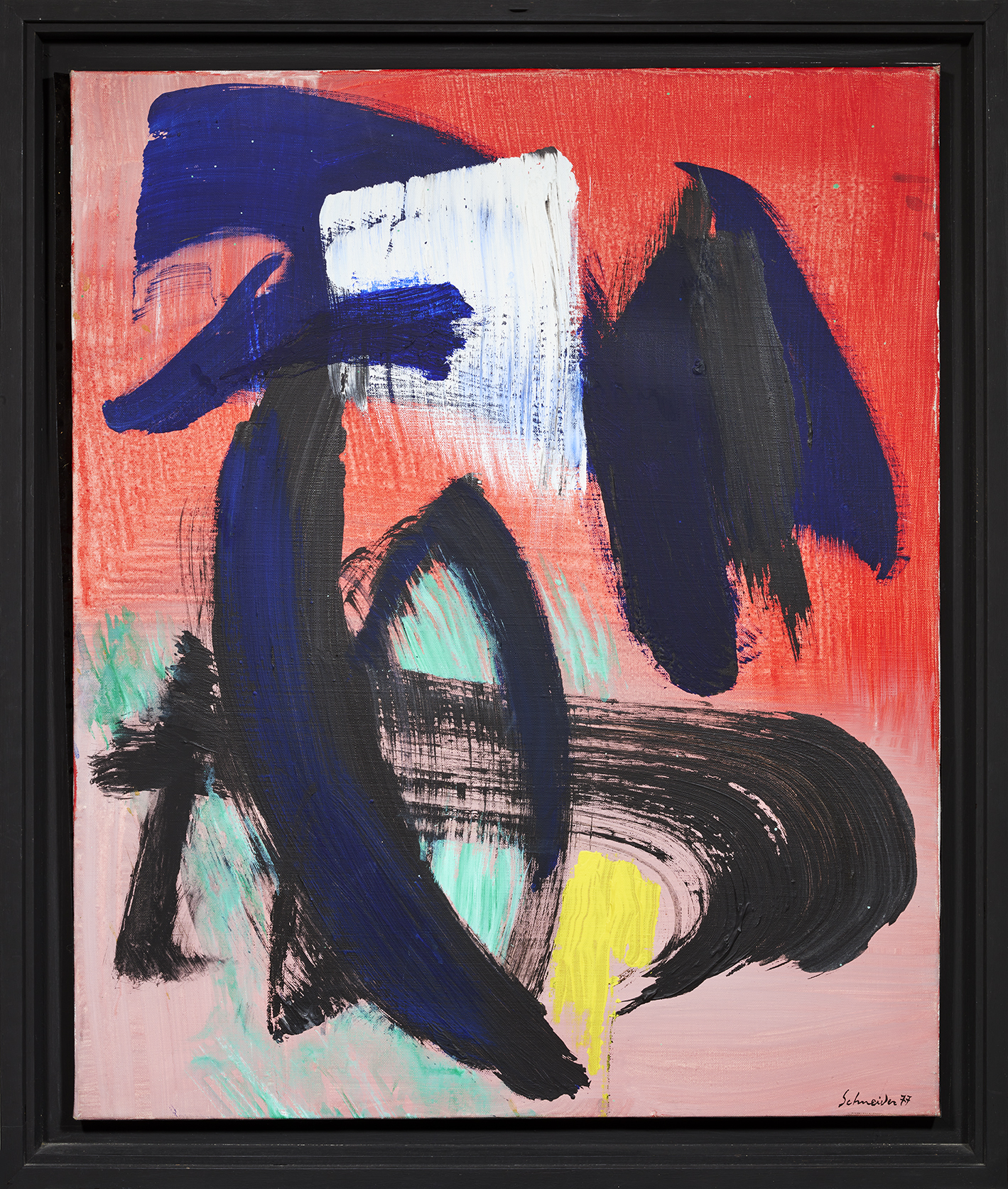Gérard SchneiderOpus 56 M
1977
Acrylic on canvas
Signed and dated
28.74 x 23.62 in ( 73 x 60 cm )ZoomInquiry - Opus 56 M, 1977
Certificat
Provenance
Dabbeni Studio d'arte contemporanea, Lugano
Private Collection, France
Artwork's description
From 1962, Schneider develops a new relationship with colour, which now occupies a primordial place in the composition.
56 M achieves this synthesis of form and colour. Here Schneider creates a composition in which the broad brushstrokes underline the expressive monumentality. The palette becomes more vivid and vibrant. He uses acrylic, which dries faster and allows him more audacity and spontaneity.
“ A change has undeniably taken place (...) on this basic priniciple united to simplified expressive forms, as heralds a logical development to come
which will succeed by its decanted lyricism, thus keeping only the pictorial essence, in a more mural sense. "
Gérard Schneider
Artist's biography
Gérard Schneider was born in Sainte-Croix, Switzerland, in 1896, and spent his childhood in Neuchâtel, where his father worked as a cabinetmaker and antiques dealer. At the age of 20, he moved to Paris to study at the École nationale des arts décoratifs, then in 1918 entered the École nationale des beaux-arts de Paris, in the atelier of Fernand Cormon, who had taught, among others, Vincent van Gogh and Henri de Toulouse-Lautrec.
In 1922, Schneider settled permanently in Paris. The 1920s and 1930s were a period of learning the techniques and history of painting for him. In 1926, he exhibited for the first time at the Salon d'Automne with his work "L'Allée hippique." He became involved in the Parisian music scene and exhibited five paintings, including "Figures dans un jardin," at the 1936 Salon des Surindépendants. These works were praised by the critic of La Revue Moderne for their "style and figures with such agility that the expression of movement is embedded in the swift brushstrokes."
During the 1930s, Schneider discovered the artistic movements of this century of upheavals and tragedies. In the mid-1930s, he assimilated the revolution initiated by Kandinsky's abstraction, while exploring the new horizons brought by surrealism. He no longer painted from nature. His palette darkened, with black playing a significant and structuring role. He wrote poems and mingled with the surrealist milieu, including Luis Fernandez, Oscar Dominguez, Paul Éluard, and Georges Hugnet.
From 1938, the titles of Schneider's works no longer referenced the real world. In 1939, he met Picasso. Around 1944, his painting definitively abandoned any reference to the real world. In 1945, the Musée national d'Art moderne purchased one of Schneider's paintings ("Composition," 1944).
In the vibrant post-war period, Gérard Schneider's art played a pioneering role in the birth of a new form of abstraction. This took shape and gained prominence in a rebuilding Europe. In Paris, Schneider and other pioneers proposed a return to the radicality of abstraction, a form with no links to the real and perceptible world. This abstraction, fully aligned with the aesthetic imperatives of this pivotal era, became known as Lyrical Abstraction.
Alongside artists like Jean-Michel Atlan, André Lanskoy, Georges Mathieu, and especially Hans Hartung and Pierre Soulages, with whom he shared a sincere friendship, Gérard Schneider saw his work gain international recognition. From the mid-1940s, major exhibitions featuring the principal members of Lyrical Abstraction were organized in Paris, notably at the galleries Lydia Conti and Denise René.
Abroad, during significant touring exhibitions, the public discovered this creative surge: throughout Germany from the late 1940s, then in the United States. From 1955 to 1961, the Samuel Kootz Gallery in New York became his exclusive dealer in the United States, showcasing his work across the Atlantic. The Phillips Gallery in Washington purchased "Opus 445" from 1950, and the MoMA in New York acquired "Opus 95 B" from 1955.
In 1956, Gérard Schneider married for the second time, to Loïs Frederick, a young American who had come to Paris to study art on a Fulbright scholarship, and whom he met through Marcel Brion. Schneider's exhibitions continued worldwide. He participated in the Venice Biennale, the Lissone Prize, the International Art Exhibition in Tokyo, the São Paulo Biennial, and the first two editions of Documenta in Kassel.
During the 1960s, Schneider maintained close ties with the Milanese dealer Bruno Lorenzelli, who dedicated numerous exhibitions to him across Italy. His painting took on a more colorful and liberated direction, with gesture acquiring a definitively calligraphic dimension.
At the 1966 Venice Biennale, an entire room in the French Pavilion was dedicated to him. Likewise, a major retrospective was held in Turin in 1970, where a hundred paintings were exhibited at the Galleria Civica d'Arte Moderna. This was a great success, and the exhibition continued at the "Terre des Hommes" Pavilion in Montreal.
At over 70 years old, Gérard Schneider's creativity remained as intense as ever. He continued to exhibit frequently, particularly with the Galerie Beaubourg in Paris. His vigor and energy were reflected in his works, executed with a speed and intensity that characterized his style. In the early 1980s, he turned almost exclusively to paper. He left behind a body of work both complex and human, an almost unfathomable exploration of color and gesture.
Gérard Schneider passed away on July 8, 1986, at the age of 90. In 1998, Michel Ragon dedicated an important monograph to him.
